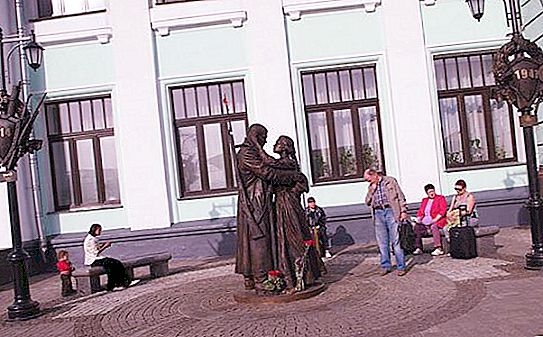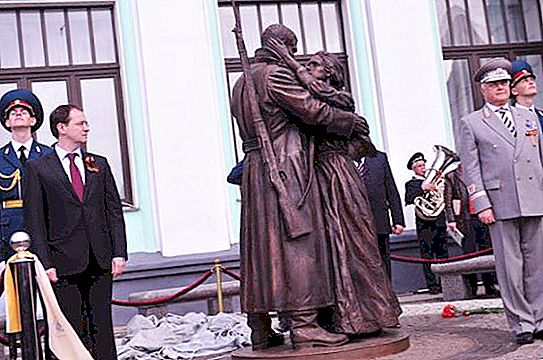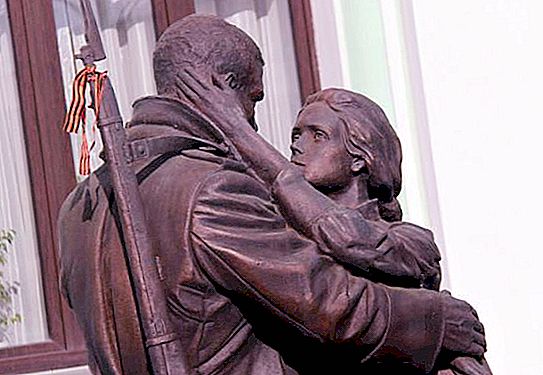In Moscow, on the territory of the Belorussky railway station, the monument “Farewell of the Slav” is dedicated to the famous military march, which was painted in the last century. How will the monument look? Who are its authors? When was it installed? Who is he dedicated to? Answers to these and other questions can be found in our article.

Opening of the monument "Farewell of the Slav"
The monument was opened on May 8, 2014 and installed on the square between the railway tracks and the building of the Belorussky railway station.
The ceremony in honor of the opening of the monument was attended by: the head of the Russian Railway, the Minister of Culture of Russia, deputies of the State Duma, the daughter of the author of the famous march - Sverdlov Aza, the authors of the monument and WWII veterans. In his solemn speech, the head of Russian Railways called the monument a symbol of devotion and loyalty to man and duty.
In an interview, the daughter of Agapkin Vasily, the author of the music of the military march, Aza Sverdlova said that she really liked the monument and that she was happy that such a touching monument was dedicated to my father’s music, expressing the only regret that he did not live up to this day.
The authors of the monument are sculptors Molokostov Vyacheslav and Shcherbakov Sergey, architect Danilov Vasily.
Description of the monument
The monument “Farewell of the Slav” was created based on the scene from the film “Cranes Are Flying” by Mikhail Kalatozov and made of bronze.
The monument is a composition that depicts a young soldier and a girl hugging his neck, seeing off to the war. On their faces, their love and desire to forever preserve in the heart the image of a loved one. The height of the sculptures is not more than two meters, and they stand on a ring, in a circle of which are engraved the words from verses written to the music of the military march “Farewell of the Slav”. On both sides of the monument are lanterns on which are attached shields indicating the dates of the beginning of the most terrible wars in the 20th century - “1914” and “1941” - and elements of weapons of the times of world wars.
The monument captures the memory not only of the Great Patriotic War, but also of the First World War. The sculptural composition presents weapons from the time of 1914, a shield with the date “1914”, and also the soldier himself is dressed in uniform of the period of the First World War. In addition, the march was written in 1912 and gained fame in 1914-1916.
The monument “Farewell of the Slav” in Moscow is dedicated to all women and girls who escorted their loved ones to the front, it is dedicated to fidelity and love.
It was no coincidence that the place for the monument was chosen; it was from this Moscow station that during the years of World War II, echelons with soldiers left for the front. The monument “Farewell of the Slav” at the Belorussky Train Station is not the only monument and commemorative sign related to the war, there is a portrait of George Zhukov, Marshal of Victory, and a memorial plaque in honor of the first performance of the hymn “Holy War” in 1941.
From the history of the famous military march
The majestic and moving military march was written by the talented composer Agapkin Vasily in 1912. The soldiers really liked him and became the main drill tune and song of the Russian army. The march was performed at the parade on Red Square on November 7, 1941, and the composer himself conducted the orchestra. That day there was such a frost that his legs froze to the pedestal so that he could not budge.
There is a legend that the march was banned by the country's leadership in Soviet times and rehabilitated only after the release of the movie “Cranes Are Flying”.
The music of the march from the very beginning interested many poets, therefore the melody has survived to its present day in its original form, but the words were copied by many of them - Shilensky V., Lazarev V., Fedotov A., Galich A., Maximov V. The very first text words to the music of the march appeared in 1914, the author of which, unfortunately, remained unknown. Currently popular is the text written in the 90s of the 20th century by Andrey Mingalev, performed by Tatyana Petrova or Zhanna, Bichevskaya.
The march was very popular in Poland, Finland, the Czech Republic, Slovakia, it is known in Israel, China and other countries.
Signs related to the monument
The monument “Farewell of the Slav” was recently opened, but signs and some traditions are already associated with it. There is an opinion that if you rub the braid of a girl, then a safe and successful road is provided, and if you rub the barrel of a rifle, you can not be afraid of the army, an accidental bullet or a vain death.
Loving couples take a photo at the monument “Farewell of the Slav”, many of them are sure that this strengthens relationships and feelings.






